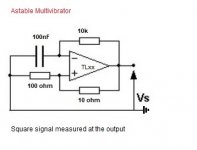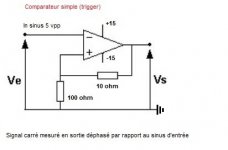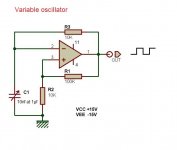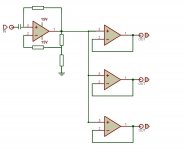I made various simple assembly to test the 4 op amps separately but in comparison with a new TL074 the readings are the same so I suspect an internal problem somewhere linking the various ops together. Anyone have other ideas ?
Attachments
Chinese components are a bit of a lottery.
Some are good and some are bad.
I only buy semiconductors I cant get elsewhere or if they are much cheaper and even then I just buy one to start with to make sure they work ok.
I use AD9201's but they are £15 in UK, at Ali Express they about £1.
So bought in a couple and they worked fine so next time I bought from same seller and got a few.
Some are good and some are bad.
I only buy semiconductors I cant get elsewhere or if they are much cheaper and even then I just buy one to start with to make sure they work ok.
I use AD9201's but they are £15 in UK, at Ali Express they about £1.
So bought in a couple and they worked fine so next time I bought from same seller and got a few.
The opamp has two inputs. You only told us about tye connection to one of them (the +input?). What did you do to the other input?I recently bought TL074 from AliExpress and they are not performing as expected.
Can you help identify if they are genuine or fake based upon the voltage follower waveform (square wave input) and the laser marking?
I created an square input signal with an NE555. The output is connected to the TL074 through a 1.1k Ohm resistor. Then for a little level shifting of the input square wave the input of the op amp is connected to Vcc with a 2k Ohm resistor and to GND with another 2k Ohm resistor.
The output is viewed with a $10 DSO138 oscilloscope. An LM317 is used to provide 15V for Vcc.
Outputs from the AliExpress purchased sample (laser marked Ti TL074) are compared with a reference genuine Ti TL074 sample purchased from an authorized distributor. The authorized distributor is Mouser.
The slew rate does not look the same. The AliExpress purchased sample is very very slow. Also the maximum and minimum output voltages are different too. So the voltage follower output signal "signature" is quite different for these AliExpress purchased samples.
Perhaps this simple and low cost test setup can be the basis of a basic fake op-amp detector? Many other DIY members have access to a scope of some sort plus NE555 to create a database of signatures and to compare their own questionable devices.
Jan
I guess your test setup will show similar results with TL072 (JFET input) an LM358 (BJT input). As the bad bandwidth points already into the direction of LM358, next step is measuring input bias current using input resistor of 1MOhm or similar. Btw, I have some LM358 stamped as NE5532: bad bandwidth, ultra-high noise, hi-THD...I made various simple assembly to test the 4 op amps separately but in comparison with a new TL074 the readings are the same so I suspect an internal problem somewhere linking the various ops together. Anyone have other ideas ?
Last edited:
I find it statistically unlikely that many Op Amps fail the exact same way, and to boot, "working but with poorer bandwidth and slew rate".I suspect an internal problem somewhere linking the various ops together. Anyone have other ideas ?
It is far more likely they were all created that way, meaning cheap LM358/324 guts.
Always go for the simplest explanation.
Like Enzo says: "when I see hoof prints in the snow, I think horses, not Zebras or Unicorns"
OK, but around here it is more likely Moose. The state agency animals-track poster doesn't show any Equus tracks.Like Enzo says: "when I see hoof prints in the snow, I think horses, not Zebras or Unicorns"
In post 13 the NE555 based square wave generator is visible on the left. [Plus reference the datasheet and the scope timebase shown on the graphs.] It is very simple but the characteristics of many opamps can be distinguished. I also use a reference (known genuine part) along with current draw measurements. On some parts I also look at the input bias currents (with a meter and appropriate resistors). On a few parts the offset/balance pins can be probed for useful information (if I recall correctly two examples are AD797 and OPA1632).
A sig gen can of course be used.
At this point I simply suggest that others buy from Digikey/Mouser/Real distributors and avoid the "usual suspects" like the plague.
A sig gen can of course be used.
At this point I simply suggest that others buy from Digikey/Mouser/Real distributors and avoid the "usual suspects" like the plague.
The opamp has two inputs. You only told us about tye connection to one of them (the +input?). What did you do to the other input?
Jan
My issue was solved last year. In my simple tests I simply looked at the voltage follower behavior.
But that is not really relevant. Someone else brought the thread back to life in post 18. It has nothing to do with my original problem.
Hello,
Yes partly because I also use a TL074. For me, these are real TLs! Some new ones purchased from major distributors of electronic components for repair and for the defective TL it was following a power failure that the defect appeared! I was only asking for the schematic you used to do your tests. My tests did not allow me to highlight the defect (see my previous posts).
Cordially.
kozard said:
Someone else brought the thread back to life in post 18. It has nothing to do with my original problem
Yes partly because I also use a TL074. For me, these are real TLs! Some new ones purchased from major distributors of electronic components for repair and for the defective TL it was following a power failure that the defect appeared! I was only asking for the schematic you used to do your tests. My tests did not allow me to highlight the defect (see my previous posts).
Cordially.
Just figure 12 on page 11 of the Ti datasheet for the NE555:
https://www.ti.com/product/NE555/part-details/NE555P
That is just setup as a simple square wave generator. That is the input to the op-amps.
The op-amps are wired as voltage followers.
This was just a very simple test circuit I put on a breadboard quickly. You could use a signal generator.
https://www.ti.com/product/NE555/part-details/NE555P
That is just setup as a simple square wave generator. That is the input to the op-amps.
The op-amps are wired as voltage followers.
This was just a very simple test circuit I put on a breadboard quickly. You could use a signal generator.
kozard said:
That is just setup as a simple square wave generator. That is the input to the op-amps.
The op-amps are wired as voltage followers
Something like this ?
Attachments
If you don't have a sig gen or a simple NE555 I guess you could use an opamp square wave generator.Something like this ?
But the idea of my little simple tester is that the rise and fall times of the square wave generator are much faster than that of the opamp being tested.
This is so that you can distinguish between real and fake opamps by observing their different "signatures" or characteristics (voltage ranges limits, rates/rise/fall times). It worked to detect the LM358 being relabeled (by the usual suspects) as better opamps. (Along with the current draw/Icq as an additional clue.) I also plugged them into the output filter on a CS4398 DAC for a distortion measurement. That is another signature as I have recorded results for a number of genuine samples.
But if you are just trying to learn about your particular stock of TL074 then you might learn something from the circuit you propose. Although I would be shocked if real/genuine Ti TL074 were really defective.
If you want to do this for educational reasons that is great. Other than that I would suggest getting more TL074 from Digikey/Mouser or other equivalent REAL distributor and finish the job.
I have an oscilloscope and a function generator !
Apparently you misunderstood me, let me explain:
I have a working TL074 in a test on an LED based circuit that flashes hopefully; which can be found here:
https://www.ebay.fr/itm/303393833917
But in reality this TL has a fault in the circuit in real situation! I noticed a strange thing with this type of tester: When testing a TL074, the tester tells me that it is good but in reality in situ in the circuit, namely an amplified subwoofer, this TL074 has a problem (big plop when switching it on and off as well as a hiss and an audible hiss) Apart from that the box works normally. The change of op amp solved the problem! (I took months to find the fault). So the little cheap tester could not highlight the problem encountered on the AOP; what measurements using an oscilloscope, function generator, etc. should be able to do; but my skills are limited. In addition, the same problem occurs on other subwoofers from different manufacturers using the same amplification card...
Apparently you misunderstood me, let me explain:
I have a working TL074 in a test on an LED based circuit that flashes hopefully; which can be found here:
https://www.ebay.fr/itm/303393833917
But in reality this TL has a fault in the circuit in real situation! I noticed a strange thing with this type of tester: When testing a TL074, the tester tells me that it is good but in reality in situ in the circuit, namely an amplified subwoofer, this TL074 has a problem (big plop when switching it on and off as well as a hiss and an audible hiss) Apart from that the box works normally. The change of op amp solved the problem! (I took months to find the fault). So the little cheap tester could not highlight the problem encountered on the AOP; what measurements using an oscilloscope, function generator, etc. should be able to do; but my skills are limited. In addition, the same problem occurs on other subwoofers from different manufacturers using the same amplification card...
- Home
- Design & Build
- Parts
- Fake Op Amp Tester? My Op Amps Genuine or Fake?



